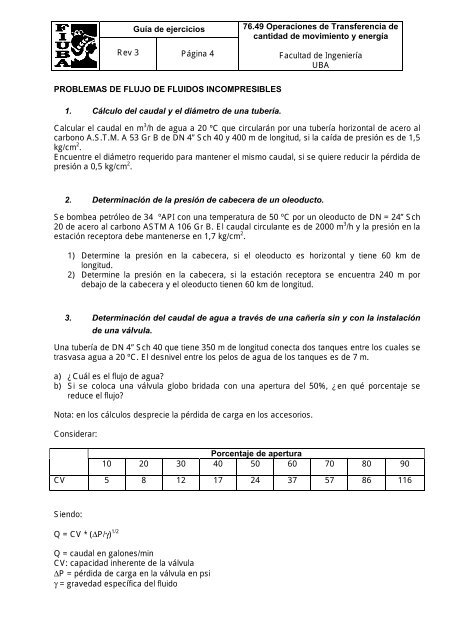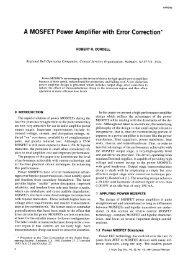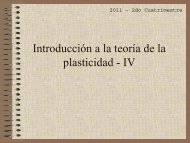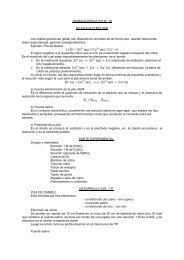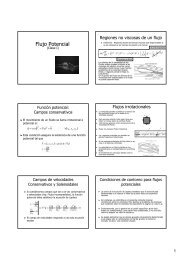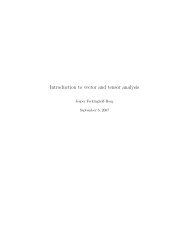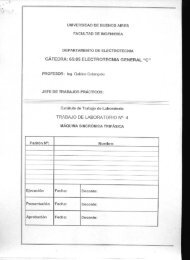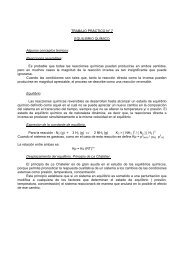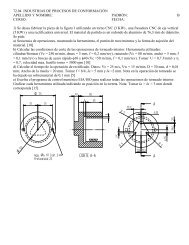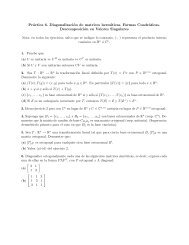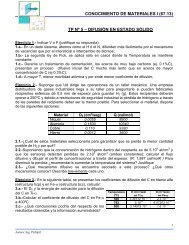Guía de ejercicios - Facultad de Ingeniería - UBA
Guía de ejercicios - Facultad de Ingeniería - UBA
Guía de ejercicios - Facultad de Ingeniería - UBA
You also want an ePaper? Increase the reach of your titles
YUMPU automatically turns print PDFs into web optimized ePapers that Google loves.
<strong>Guía</strong> <strong>de</strong> <strong>ejercicios</strong><br />
Rev 3 Página 4<br />
PROBLEMAS DE FLUJO DE FLUIDOS INCOMPRESIBLES<br />
1. Cálculo <strong>de</strong>l caudal y el diámetro <strong>de</strong> una tubería.<br />
76.49 Operaciones <strong>de</strong> Transferencia <strong>de</strong><br />
cantidad <strong>de</strong> movimiento y energía<br />
<strong>Facultad</strong> <strong>de</strong> <strong>Ingeniería</strong><br />
<strong>UBA</strong><br />
Calcular el caudal en m 3 /h <strong>de</strong> agua a 20 ºC que circularán por una tubería horizontal <strong>de</strong> acero al<br />
carbono A.S.T.M. A 53 Gr B <strong>de</strong> DN 4” Sch 40 y 400 m <strong>de</strong> longitud, si la caída <strong>de</strong> presión es <strong>de</strong> 1,5<br />
kg/cm 2 .<br />
Encuentre el diámetro requerido para mantener el mismo caudal, si se quiere reducir la pérdida <strong>de</strong><br />
presión a 0,5 kg/cm 2 .<br />
2. Determinación <strong>de</strong> la presión <strong>de</strong> cabecera <strong>de</strong> un oleoducto.<br />
Se bombea petróleo <strong>de</strong> 34 ºAPI con una temperatura <strong>de</strong> 50 ºC por un oleoducto <strong>de</strong> DN = 24” Sch<br />
20 <strong>de</strong> acero al carbono ASTM A 106 Gr B. El caudal circulante es <strong>de</strong> 2000 m 3 /h y la presión en la<br />
estación receptora <strong>de</strong>be mantenerse en 1,7 kg/cm 2 .<br />
1) Determine la presión en la cabecera, si el oleoducto es horizontal y tiene 60 km <strong>de</strong><br />
longitud.<br />
2) Determine la presión en la cabecera, si la estación receptora se encuentra 240 m por<br />
<strong>de</strong>bajo <strong>de</strong> la cabecera y el oleoducto tienen 60 km <strong>de</strong> longitud.<br />
3. Determinación <strong>de</strong>l caudal <strong>de</strong> agua a través <strong>de</strong> una cañería sin y con la instalación<br />
<strong>de</strong> una válvula.<br />
Una tubería <strong>de</strong> DN 4” Sch 40 que tiene 350 m <strong>de</strong> longitud conecta dos tanques entre los cuales se<br />
trasvasa agua a 20 ºC. El <strong>de</strong>snivel entre los pelos <strong>de</strong> agua <strong>de</strong> los tanques es <strong>de</strong> 7 m.<br />
a) ¿Cuál es el flujo <strong>de</strong> agua?<br />
b) Si se coloca una válvula globo bridada con una apertura <strong>de</strong>l 50%, ¿en qué porcentaje se<br />
reduce el flujo?<br />
Nota: en los cálculos <strong>de</strong>sprecie la pérdida <strong>de</strong> carga en los accesorios.<br />
Consi<strong>de</strong>rar:<br />
Porcentaje <strong>de</strong> apertura<br />
10 20 30 40 50 60 70 80 90<br />
CV 5 8 12 17 24 37 57 86 116<br />
Siendo:<br />
Q = CV * (ΔP/γ) 1/2<br />
Q = caudal en galones/min<br />
CV: capacidad inherente <strong>de</strong> la válvula<br />
ΔP = pérdida <strong>de</strong> carga en la válvula en psi<br />
γ = gravedad específica <strong>de</strong>l fluido


